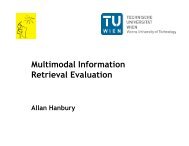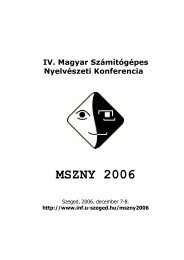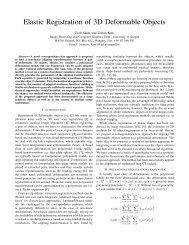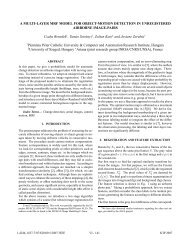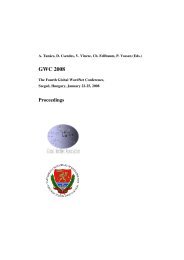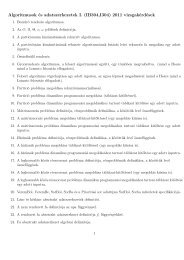1. Introduction What is Vision? Active Visual Perception
1. Introduction What is Vision? Active Visual Perception
1. Introduction What is Vision? Active Visual Perception
Create successful ePaper yourself
Turn your PDF publications into a flip-book with our unique Google optimized e-Paper software.
Zoltan Kato: Computer V<strong>is</strong>ion<br />
Depth Cues: Binocular D<strong>is</strong>parity<br />
• Each eye receives a slightly different image of the<br />
world from which 3D positions can be inferred.<br />
• D<strong>is</strong>parity - The difference in retinal position<br />
between the corresponding points in two images.<br />
D<strong>is</strong>parity <strong>is</strong> inversely proportional to the depth of the<br />
point in space.<br />
Zoltan Kato: Computer V<strong>is</strong>ion<br />
Theory of V<strong>is</strong>ual <strong>Perception</strong><br />
• The information we receive<br />
by our eyes <strong>is</strong> relatively<br />
impover<strong>is</strong>hed.<br />
• For example, the retina<br />
receives a grainy 2D image of<br />
the v<strong>is</strong>ual scene…<br />
• …that includes large gaps<br />
(blind spots)…<br />
• …and an uneven<br />
representation of colour<br />
(cones) and luminance (rods).<br />
• Th<strong>is</strong> information <strong>is</strong><br />
transformed into a rich<br />
v<strong>is</strong>ual experience.<br />
21<br />
23<br />
Zoltan Kato: Computer V<strong>is</strong>ion<br />
Perceptual Constancy<br />
Size constancy<br />
• We tend to experience objects as the same, despite the<br />
image they produce on the retina may vary greatly.<br />
• Shape constancy – objects seen from different angles do not appear<br />
different or to change shape<br />
• Size constancy – objects do not seem to change size when they move<br />
nearer or further away.<br />
• Color constancy – differing illumination does not affect color despite<br />
changes in the actual reflected light.<br />
Zoltan Kato: Computer V<strong>is</strong>ion<br />
Theory of V<strong>is</strong>ual <strong>Perception</strong>: Marr<br />
• Theories of v<strong>is</strong>ual perception attempt to explain how<br />
th<strong>is</strong> happens.<br />
• David Marr: V<strong>is</strong>ion: A Computational Investigation<br />
into the Human Representation and Processing of<br />
V<strong>is</strong>ual Information, 1982.<br />
• wanted to understand mechan<strong>is</strong>ms of v<strong>is</strong>ion rather<br />
than just behaviours associated with it.<br />
• He took an information processing view of the mind…<br />
• …and aimed to describe perception in terms of<br />
computations on sense data…<br />
• …to extract high level v<strong>is</strong>ual experience.<br />
22<br />
24







